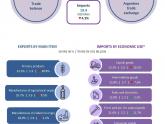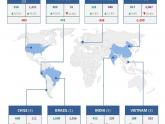Wednesday, 22 March 2023
In the first two months of the year exports totalled US$ 10.2 billion, while imports amounted to US$ 10.4 billion, resulting in a deficit trade balance of US$ 261 million.
Highlights:
- Between January and February 2023, exports totalled US$ 10.2 billion, the second highest value for that period since 2013, surpassed only by the same two-month period of 2022. External sales accumulate a year-on-year contraction of 15.4%, which is explained by a fall of 15.1% in quantities and of 0.3% in prices. Exported values of all major items fell, except for Fuels and energy.
- Imports amounted to US$ 10.4 billion in the first two months of the year. They dropped 4.3%, as a result of a 6.1% contraction in quantities that outpaced the 1.9% increase in prices. This decrease was explained by lower imported quantities of Capital goods and Passenger motor vehicles and, to a lesser extent, Intermediate goods and Consumer goods. There stand out the increases in the imported values of Parts and accessories for capital goods, due to greater quantities, and Fuels and lubricants, due to price rises.
- The trade balance was a deficit of US$ 261 million, resulting from the greater contraction of exports than of imports, while in the same period of 2022 a surplus of US$ 1.1 billion had been achieved.

- The largest export decreases were seen in wheat (−US$ 1.4 billion), soybean meal and pellets (−US$ 369 million), corn (−US$ 142 million) and crude oil (−US$ 130 million). The main increases correspond to motor vehicles for the transport of goods –pickups– (US$ 146 million); soybean oil (US$ 113 million) and natural gas in gaseous state (US$ 86 million).
- It is worth highlighting the increases in the export prices of all the products of the soybean complex: flour, 23.7%, beans, 23.0%, and biodiesel, 17.6%; whereas those of oil decreased (−8.3%). In relation to the quantities exported, decreases were recorded in flours and pellets (−18.6%), beans (−6.2%) and biodiesel (−1.7%); while those of oil increased (8.3%).
- Regarding imports, the largest purchases of soybeans (US$ 161 million), electrical energy (US$ 121 million) and iron or steel pipes used in oil and gas pipelines (US$ 86 million) stand out, while purchases of automatic machine units for data handling or processing (−US$ 93 million), semi-finished products of iron or non-alloy steel (−US$ 83 million), gasoline, excluding that for aviation, (−US$ 72 million) and vaccines (−US$ 67 million) decreased.

- The three main partners, Brazil, China and the United States, absorbed as a whole 32.8% of the exports and supplied 54.1% of the imports in these first two months. In turn, the European Union concentrated 10.3% of shipments and 15.7% of purchases.
- The largest surpluses were in trade with Chile (US$ 587 million), Peru (US$ 478 million), Indonesia (US$ 243 million), Colombia (US$ 218 million) and India (US$ 173 million).
- The highest deficits were recorded with China (US$ 1.3 billion), Brazil (US$ 748 million), Germany (US$ 326 million), United States (US$ 305 million) and Thailand (US$ 218 million).
Related documents:




